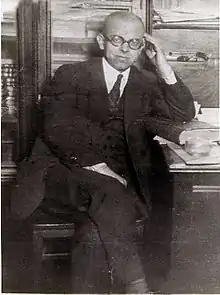Elia Abu Madi
Elia Abu Madi (also known as Elia D. Madey; Arabic: إيليا أبو ماضي Īlyā Abū Māḍī [note 1]) (May 15, 1890 – November 23, 1957) was a Lebanese poet.
Elia Abu Madi | |
|---|---|
 | |
| Born | إيليا أبو ماضي (Īlyā Abū Māḍī ) May 15, 1890 Mount Lebanon Mutasarrifate, Ottoman Syria |
| Died | November 23, 1957 (aged 67) New York, United States of America |
| Occupation | poet, journalist, publisher |
| Nationality | Lebanese |
| Genre | poetry |
| Literary movement | Mahjar (The Pen League), New York City |
| Relatives | [1] |
Early life
Abu Madi was born in the village of Al-Muhaydithah, now part of Bikfaya, Lebanon, on May 15, 1890 to a Greek Orthodox Christian family. At the age of 11 he moved to Alexandria, Egypt where he worked with his uncle.
Career and Works
In 1911, Elia Abu Madi published his first collection of poems, Tazkar al-Madi. Shortly after, he was exiled by the Ottoman Turkish authorities[2] and he left Egypt for the United States, where he settled in Cincinnati, Ohio. In 1916 he moved to New York City and began a career in journalism. In New York Abu Madi met and worked with a number of Arab-American poets including Kahlil Gibran. He married the daughter of Najeeb Diab, editor of the Arabic-language magazine Meraat-ul-Gharb, and became the chief editor of that publication in 1918. His second poetry collection, Diwan Iliya Abu Madi, was published in New York in 1919; his third and most important collection, Al-Jadawil ("The Streams"), appeared in 1927. His other books were Al-Khama'il ("The Tickets")[3](1940) and Tibr wa Turab (posthumous, 1960).
In 1929 Abu Madi founded his own periodical, Al-Samir, in Brooklyn. It began as a monthly but after a few years appeared five times a week.
His poems are very well known among Arabs; poet, author, and journalist Gregory Orfalea wrote that "his poetry is as commonplace and memorized in the Arab world as that of Robert Frost is in ours."[note 2]
See also a photo of Elia Abu Madi as a member of al-Rabita (Pen League).
See also
Notes
- Lebanese Arabic Transliteration: Īlya Abu Māḍi, pronounced [ˈʔiːlja (ʔa)buˈmɑːdi].
- In A Community of Many Worlds: Arab Americans in New York City, ed. Kathleen Benson, Syracuse University Press, 2002, page 62.
Scholarly criticism
- Ahmad, Imtyaz. "Abu Madi: A Voice of Modernity in Contemporary Arabic Poetry" (PDF). Retrieved July 30, 2016.
- Alawi, Nabil. "Arab American Poets: The Politics of Exclusion and Assimilation" (PDF).
- Boullata, Issa J. "Iliya Abu Madi and the Riddle of Life in His Poetry" Journal of Arabic Literature, 1986; 17: 69-81. (journal article)
- Nijland, Cornelis. "Religious Motifs and Themes in North American Mahjar Poetry" pp. 161–81 IN: Borg, Gert (ed. and introd.); De Moor, Ed (ed.); Representations of the Divine in Arabic Poetry. Amsterdam, Netherlands: Rodopi; 2001. 239 pp. (book article)
- Romy, Cynthia Johnson. Diwan Al-Jadawil of Iliya Abu Madi (Masterʻs thesis, University of Arizona). Retrieved from http://hdl.handle.net/10150/291551
References
- Marmorstein, Emile (October 1964). "Rāshid Husain: Portrait of an Angry Young Arab". Middle Eastern Studies. 1 (1): 3–20. doi:10.1080/00263206408700002.
- Orfalea, Gregory (2002). Benson, Kathleen; Kayal, Philip (eds.). My Mother's Zither. New York: Syracuse University Press. p. 63. ISBN 0815607393.
- Ahmad, Imtyaz. "Abu Madi: A Voice of Modernity in Contemporary Arabic Poetry" (PDF). Retrieved July 30, 2016.
Sources
| Library resources about Elia Abu Madi |
| By Elia Abu Madi |
|---|
- Salma Khadra Jayyusi, Trends and Movements in Modern Arabic Poetry, Brill, 1977.
- Encyclopedia of Islam, Brill, 1980.
- The New Anthology of American Poetry, eds. Steven Gould Axelrod, Camille Roman, Thomas J. Travisano, Rutgers University Press, 2005.
- Orfalea, Gregory; Elmusa, Sharif, eds. (1999). Grape Leaves: A Century of Arab-American Poetry. New York: Interlink. pp. 65–82. ISBN 1566563380.
- Poeti arabi a New York. Il circolo di Gibran, introduzione e traduzione di F. Medici, prefazione di A. Salem, Palomar, Bari 2009. ISBN 88-7600-340-1. ISBN 978-88-7600-340-0.